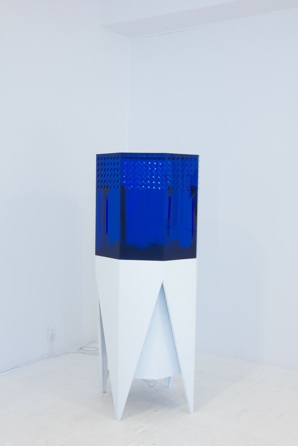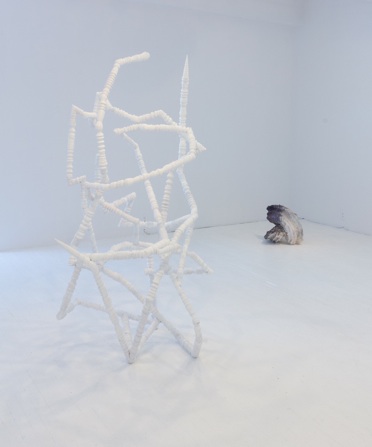Thanatopsis
- Philippe CARON-LEFEBVRE
“In a small remote room, among other composite elements, a multiform structure was constructed with an approximate height of five feet. Arid fluorescent light illuminates everything. The object consists of two parts: the lower part, white and lustrous, was placed on the ground with four triangular feet; the upper part, octagonal and a translucent blue, was dotted with repeated small openings. In its center, something was stirring gently, peacefully. ”
Similar to a model spacecraft that might appear in a science fiction story, this stoic structure becomes an enigma. Against the background of parallel universes, dystopian stories, terrifying worlds and speculative fiction, this artifact could be the remnant of a past civilization or of a future society. At the intersection of archeology and science fiction, Thanatopsis evokes a vague and suspended temporality, cryogenized.
Millions of years old, the scorpion image is full of significance, relating to death, resilience, healing and regeneration. Like a sentry in charge of monitoring the room, equipped with clamps and secreting a deadly poison, this animal appears threatening and fatal in the eyes of many. The scorpion is a dark, wild and unpredictable figure that both attracts and repels.
Around this central figure, the collected works are marked by symmetry and balance. The terrarium is surrounded by pictorial and sculptural objects with patterns and motifs that evoke the curves and swirls of nature. The drawings of folded complex configurations are analoguous to evolutionary crystal structures. The sculptures, in turn, are inspired by the tree structures: patterns and textures reminiscent of the branches of a tree and the irridescent preciousness of certain stones or metals. Their mysterious and volatile surfaces seem alive and as though coming from another planet.
An artist of seductive material and formal explorations, Philippe Caron Lefebvre takes us to the center of a paradoxical landscape that is half-natural and half-artificial, where the visitor becomes an actor in a spooked story. Thanatopsis seems to place us under both favorable and fatal auspices at the same time. Although the artist evokes this scene of a dehumanized world, it also reminds us that everything around us resists and adapts over time.
Through the intermediary of science-fiction, beauty and the use of organic and geological forms, Thanatopsis encourages us to think and rethink about surrounding nature, the evolution of living, obsolescence, resilience and the future.
Anne Philippon
Philippe Caron Lefebvre is from the Laurentians in Quebec. He holds a Bachelor’s degree in visual and media arts from UQAM and completed his Master’s degree at Concordia University in sculpture. His works have been shown in various art centers and galleries in Quebec and in Mexico. In 2013 he was awarded both the Young Artist Award of the Laurentians and a Research and Creation grant from the Conseil des Arts et des Lettres du Quebec. Through various mediums, he explores the concept of evolution, especially in regard to the survival mechanisms of plants and animals along with the archaeological status of sculptural objects throughout history. He also is interested in how our surrounding systems are articulated, creating works in which there is a relationship to power. Whether through the representation of a position of authority or the symbolic representation of defensive forces, this relationship to power seeks to alter our perception of the work and even more so, the relationship we have with our environment. He gathers and presents his works in the exhibition space in order to create a dialogue between his different media by staging a combination of an industrial workshop, a natural history museum and a sci-fi dystopia.
Anne Philippon has a BA in Film Studies from the University of Montreal and a BA in art history from UQAM. She holds a master’s degree in arts from UQAM. Her thesis focused on an updated consideration on the theme of vanity in contemporary art practice. Very involved in the arts, she coordinates projects for contemporary artists. Moreover, she contributes critical writing to various Quebec magazines devoted to contemporary art. Since 2010, she has worked at the Galerie de l’UQAM and the Association of Contemporary Art Galleries (AGAC).






















